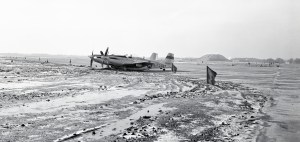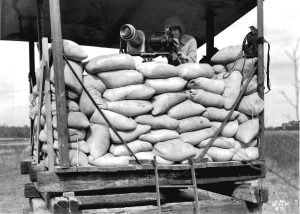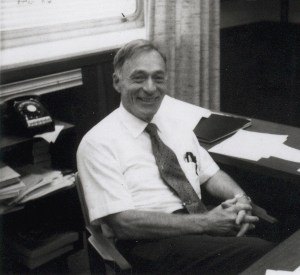Excerpted from NASA SP-4306, “Engines and Innovation: Lewis Laboratory and American Propulsion Technology” by Virginia P. Dawson.
In 1947, the Committee on Operating Problems, chaired by the charismatic executive of American Airlines, William Littlewood, debated the question of whether the National Advisory Committee for Aeronautics, NASA’s predecessor, should enter a new area of aircraft safety – the control or prevention of fires after an airplane crash. The Committee directed Lewis Laboratory (now NASA Glenn) to make a preliminary study of the crash fire problem. At the same time, it took steps to form a new Subcommittee on Aircraft Fire Prevention. The crash fire issue was of direct concern to the aircraft industry, to the aircraft manufacturers, and to increasingly successful commercial airline operators like American, United, Trans World (TWA), and Pan American. They pushed for a greater involvement with the crash fire problem on the part of the NACA.
By 1949, NACA obtained about 50 twin-engine cargo planes from the Air Force. These planes had been used in the Berlin airlift and were so service weary that they were flown to Cleveland with their doors open so that the pilot could jump, if necessary. The Army granted the NACA permission to use the grounds of one of its World War II arsenals in Ravenna, Ohio, as the site for the full-scale crash tests. John Everett designed and supervised the construction of a 2000-foot runway.
The crashes were carefully choreographed. They were to be survivable, assuming that a fire could be prevented. A plane was sent down the runway at take-off and landing speeds by remote control. It ran into a barrier that tore off the landing gear and damaged the propellers. The engine, however, had to remain attached to the main body of the aircraft. The plane then slid through a set of poles to rip open the wing tanks before sliding into an open field. The airplane was painted white and the fuel dyed red for ease of photography.
Each airplane carried various instruments to record temperatures, fire location, distribution of combustible mixtures, and times at which various failures occurred. These instruments converted the data into electric signals recorded on meters located in a fireproof, insulated box on the airplane. Seven additional motion-picture (426K mpeg) camera stands were located at various points near the runway. To correlate the exterior photographs with the data simultaneously photographed inside the box, a timing light on the top of the fuselage flashed at intervals of one second or less.
The program’s goal was to uncover the mechanism of the crash fire and the exact nature of the structural breakup of the airplane. What was the rate, pattern, and area over which the liquid fuel spread? Did it form into a spray? What, if anything, could be done to prevent it? One by one the old myths tumbled before the facts: the mistaken idea of pilots that turning off the ignition before a crash prevented fire; the belief that fuels with low volatility were safer than conventional gasoline.
By 1957 the group had extended their careful engineering analyses from piston engine aircraft to planes powered by turbojets. They received strong support from the airlines, particularly United, for work on a design for an inerting system, despite a projected weight penalty of 1200 pounds. Pratt & Whitney was less enthusiastic. Representatives objected that over 50 holes drilled into the engine case of the J-57 for a spray system might affect the engine’s reliability. The team designed an inerting system that could cool the hot exhaust system and cut off the fuel and electrical systems within this short interval. With the inerting system to prevent the ensuing crash fire, all but the most severe crashes were survivable.
However, the NACA had no political clout to force the airframe and engine manufacturers to install the new system. Despite the desire of some of the airline operators to purchase aircraft with crash fire protection, the manufacturers were under no obligation to provide this added equipment. The Civil Aeronautics Administration, possibly alienated by the NACA’s strong showing in a field that it had previously dominated, did not take up the cause to force compliance through regulation. Unlike the icing criteria, which became the basis for federal design standards, for fire safety the NACA had to rely on persuasion, and the manufacturers were not ready to make the investment. Although the Crash Fire Program had provided convincing evidence that the inerting system could prevent crash fires, the added weight of the system forestalled acceptance. Even with a motion-picture film, convincingly narrated by David Brinkley, the NACA failed to entice the manufacturers to incur the added expense of the system.
Although the aircraft manufacturers did not adopt the NACA inerting system in the mid-1950s, gradually designers incorporated safety features similar to those recommended by the NACA. Fires following crashes became rare.
Concern with safety continued to shape operations research programs at Lewis Laboratory. From the Crash Fire Program, Pinkel and his group moved into the investigation of the crash-worthiness of airline seats, restraining harnesses for passengers, design of seats to reduce impact forces, maximum seating density, and lightning hazards. In the late 1950s, when NASA’s Mercury Program required engineers with experience in protecting human beings from the buffeting of crash landings, Lewis was ready with an experienced cadre of individuals.
References:
Irving Pinkel, G. Merrit Preston, and Gerad J. Pesman, ” Mechanism of Start and Development of Aircraft Crash Fires,” NACA Technical Report 1133, 1953.
Film TF-26: G.M. Preston and I.I. Pinkel, “NACA Crash Fire Research,” 1953. Cited in NACA Film Catalogue, Lewis Flight Propulsion Laboratory.






























